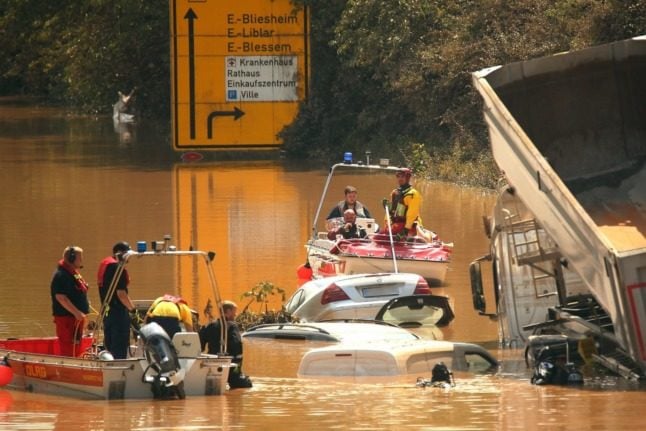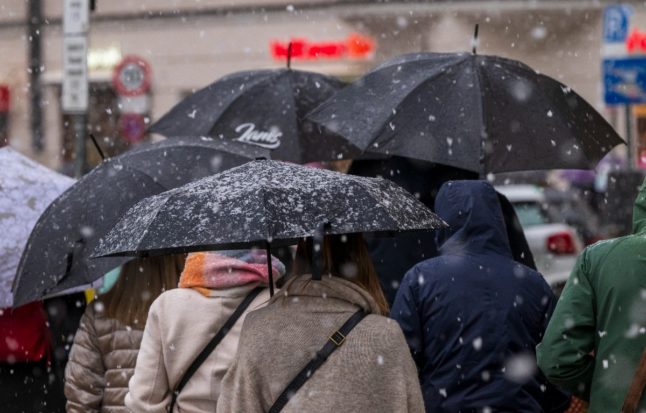The German government has promised more than €400 million in aid for Rhineland-Palatinate and North Rhine-Westphalia – the two states hit hardest by the flooding catastrophe.
German Finance Minister Olaf Scholz said funding would be “quick, generous and unbureaucratic.”
However, many volunteers and agencies are on the disaster scene right now and calling for cash donations.
Here’s a look at some of the agencies helping out flood victims:
The DRK provides huge support in emergencies, such as medical services, care, accommodation and food. You can donate to the flood victims via the DRK website. This can be done via bank transfer and via online payment services such as Paypal.
READ ALSO: ‘Unbelievable tragedy’: Germany vows to improve flood warning system
The German Life Saving Association (DLRG)
The DLRG is involved in water rescue. They have been at the scene in boats helping to sort through the wreckage. They request that people contact the three regional associations (North Rhine, Westphalia or Rhineland-Palatinate) to donate money. Donations to the respective accounts should be marked with the keyword “Hochwassereinsatz 2021” so it’s clear what the money is intended for. Further information can be found on the homepage.
Stiftung THW – Foundation for Technical Relief
The THW foundation helps out at the scene of disasters and civil protection. They have around 80,000 volunteers across Germany.
Malteser Germany has around 300 volunteers on flood relief missions, with hundreds more on standby.
“The operational situations in Rhineland-Palatinate and North Rhine-Westphalia are dramatic and still constantly changing.” said Malteser Help Service President Georg Khevenhüller. “The danger to the lives of residents affected by the floods and also to colleagues in the fire department, for example, are very high. We think especially of the relatives of the deceased in these hours.”
Chaplains are provided by this organisation amongst other support.
Aktion Deutschland Hilft has also set up a donation account for flood victims. It provides emergency aid to the people affected, helping families who have lost their homes.
Regional charity the Diakonie Wuppertal is asking for donations for all Wuppertal residents who have become victims of the floods.
When donating via bank transfer, the key word is “Hochwasser” (flood).
Donate to the districts
People can also contact the districts affected. The Federal Office of Civil Protection and Disaster Assistance has listed them on its homepage.
Donation account for victims in Rhineland-Palatinate
The state government in Rhineland-Palatinate has set up a donation account for those affected in the state. The details for bank transfer are:
Landeshauptkasse Mainz
IBAN: DE78 5505 0120 0200 3006 06
BIC: MALADE51MNZ
Keyword: “Katastrophenhilfe Hochwasser”
“We are currently receiving numerous inquiries about how to support the people affected by the severe weather disaster in Rhineland-Palatinate. This shows that there is a real willingness to help among the population,” said state interior minister Roger Lewentz this weekend.
READ ALSO: ‘Solidarity in crisis’: Financial aid pours in for German flood victims
Should I donate items?
At the moment most of the larger charities are only asking for cash donations because they do not have the capacity to accept donations in kind – such as clothes or toiletries – at this time.
However, there are some local organisations, particularly on social media, that may be looking for clothes and toiletries.
How can I recognise a reputable organisation?
One indication of a reputable organisation is the seal of the German Central Institute for Social Issues (DZI). If an appeal for donations bears the logo, it is guaranteed that the organisation advertises clearly and objectively, operates economically and also verifiably shows how the donors’ money is used.
However smaller charities may not have this logo so it doesn’t necessarily mean they are not genuine.
If you are donating to groups found on social media that you are not previously aware of, try to check that the person’s profile is genuine and get some information about them before sending a payment. While the majority of offers of help are genuine, it’s possible that scammers will exploit the opportunity.
Please read & rt/like this!!!
#floodinggermany
#Flutkatastrophe
Firstly to every non german and german person, please consider donating to charities supporting the affected people living in western germany!Links to support are at the end of thread 🧵
tw // death, flooding pic.twitter.com/2L1OmVXpBL
— Mari ❀ is struggling (@fooIshabit) July 19, 2021
Should I go to the area to help?
No. Organisations and local authorities have also asked that people do not travel to the flood areas to help at the scene. There is a coordinated rescue response ongoing and there are still danger spots in some regions.



 Please whitelist us to continue reading.
Please whitelist us to continue reading.
Member comments